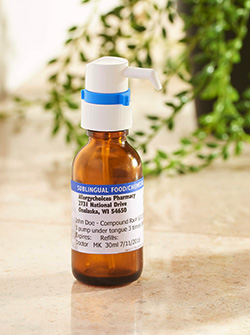Food Allergy Treatment
 Sublingual immunotherapy for food allergy is not limited to those who are severely food allergic. There are a number of factors to consider for a patient you suspect has food allergy.
Sublingual immunotherapy for food allergy is not limited to those who are severely food allergic. There are a number of factors to consider for a patient you suspect has food allergy.
The current standard of care for food allergy is limited to strict avoidance of food allergens and ready access to self-injectable epinephrine. Despite best efforts, accidental exposures can and do occur.
Many of the same symptoms elicited from environmental allergies such as runny nose, mouth itching, hives, eczema and skin itching can also be attributed to food allergies.
The goal of sublingual immunotherapy treatment for food allergy varies from patient to patient:
- Mild to moderate food allergies — it may be possible to reintroduce allergic foods into the diet
- Severe and life threatening allergies — the goal is to reduce the likelihood of a severe allergic reaction due to an accidental exposure.
Allergychoices offers multi-allergen food threshold treatment using the La Crosse Method™ Protocol. Food allergy treatment can be provided to patients who test positive for food allergies, and is most often prescribed in conjunction with inhalant allergy treatment.
The treatment level for food allergy drops is based on the individual patient’s skin or blood test results. Treatment levels are gradually increased as the patient’s test results show improvement. Patients take three doses daily using a metered dispenser. Each prescription lasts 90 days.
Similar to sublingual immunotherapy treatment for environmental allergies, the duration depends on the patient’s allergy severity and adherence to treatment. For mild to moderate allergies, a common range is three to five years with more severe food allergy cases taking longer. For patients with anaphylaxis, ongoing allergy drops may provide the best relief and protection.
